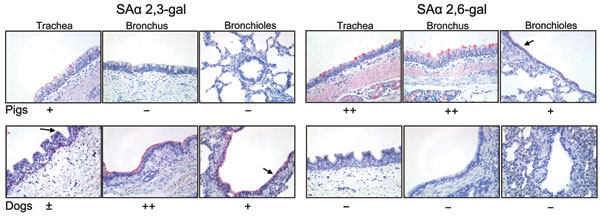Volume 14, Number 5—May 2008
Research
Transmission of Avian Influenza Virus (H3N2) to Dogs
Figure 4

Figure 4. Lectin staining (red stain) for SAα 2,3-gal (avian influenza virus receptors) and SAα 2,6-gal (human influenza virus receptors) in canine trachea, bronchus, and bronchioles, together with porcine tissues as a positive control. Original magnification all x300. −, no staining; ±, rare or few positive cells; +, moderate numbers of positive cells; and ++, many positive cells.
Page created: July 08, 2010
Page updated: July 08, 2010
Page reviewed: July 08, 2010
The conclusions, findings, and opinions expressed by authors contributing to this journal do not necessarily reflect the official position of the U.S. Department of Health and Human Services, the Public Health Service, the Centers for Disease Control and Prevention, or the authors' affiliated institutions. Use of trade names is for identification only and does not imply endorsement by any of the groups named above.